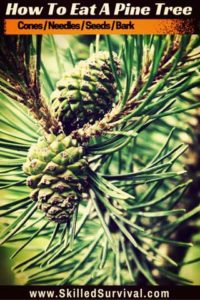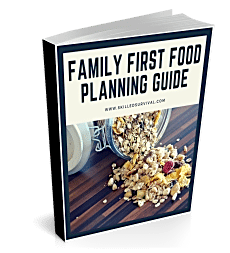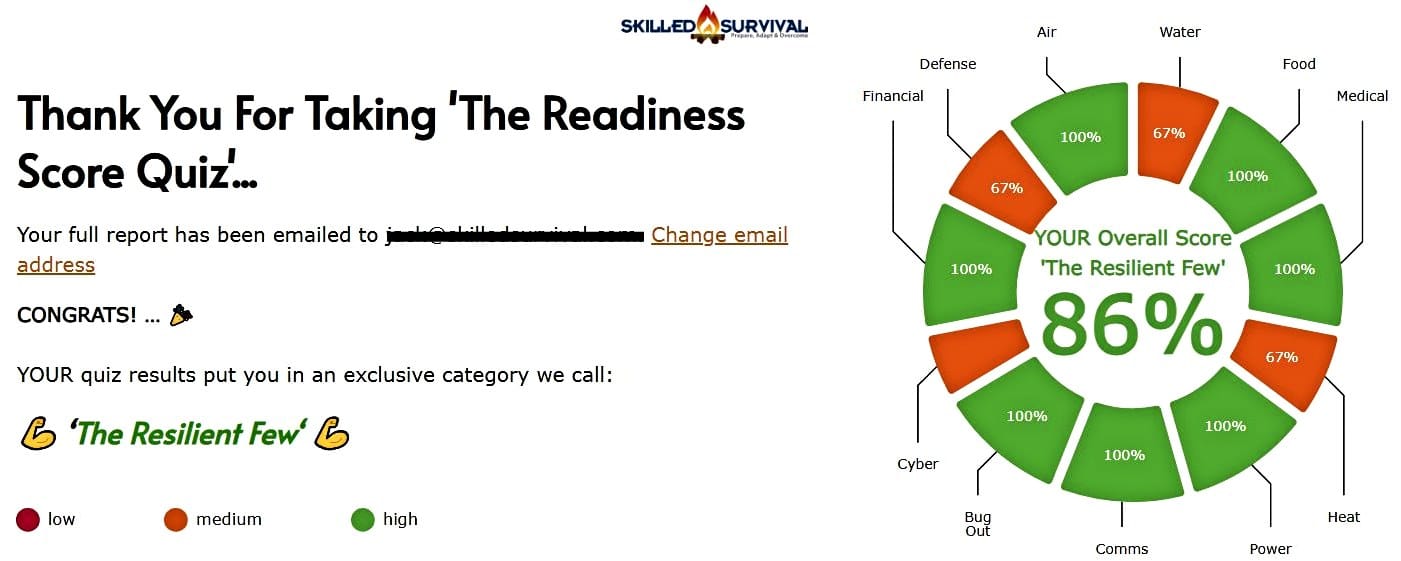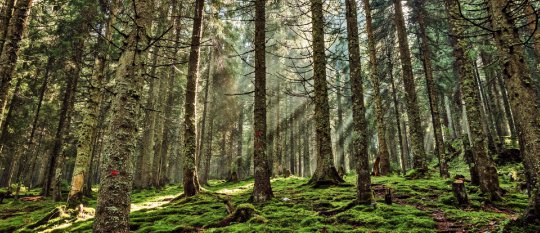
All the surprising ways you can eat a pine tree, from:
- The Cones
- The Needles
- The Pollen
- The Bark
But only IF you learn HOW to prepare them for consumption:
TOPICS IN THIS ARTICLE… ↓(click to jump)
- How A Pine Tree Can Save
- Eating Pine Is Good For You
- The History of Eating Pine Trees
- Getting Started The Right Way
- 4 Edible Parts of The Pine Tree
How Eating A Pine Tree Could Save Your Life
Imagine it’s been days since you last saw a road.
A full week since your last human contact.
You’re stranded. Lost. Alone.
Without amenities, and worst of all, without food.
Only vast, seemingly endless wilderness surrounds you.
As far as you can see, birds, bees, animals, emptiness, and pine trees.
Your stomach rumbles, a growling reminder that your last meal was long ago.
And that meal was the last of your meager rations.
There are:
- No more potato chips
- No more Snickers bars
- And no more trail mix
Imagine you don’t have any way to hunt or catch food.
No fishing pole or reliable means of trapping, snaring, or killing wild game.
In such a dire situation, what options remain?
Luckily, almost everything around you is edible.
Because a pine tree is an edible plant.
And while eating a pine tree is no substitute for fresh trout (or better yet, emergency survival food), in a pinch, it CAN keep you going.
When your life depends on getting sustenance and nutrients, pine trees are there to lend some.
Knowing how to eat a pine tree is the kind of survival skill that could save your life.
But it is not quite as simple as one might imagine.
Believe it or not, you cannot simply chop down a lodgepole and begin chomping away.
There is a method to it.
But fear not!
That is what I am here to explain.
What follows is a comprehensive guide to eating yourself a pine tree.
And you may be pleasantly surprised once you put this survival knowledge to the test.
Pine trees are astonishingly palatable.
↓ Pine Trees Are Edible & Very Useful
Why Eating Pine Trees Is Good For You
Getting lost in a vast pine forest is a “fortunate curse.”
Sure, it sucks getting lost, but it’s also nice that you’re not destined for starvation.
But this outcome is only available to those who learn to eat a pine tree.
Most people don’t see a bountiful source of sustenance when they look at a pine tree.
Besides being naturally beautiful, pine trees are a wonderful source of nutrients and vitamins.
No matter which part of the tree you eat or how you prepare it, consuming pine will provide a healthy dose of vitamin C and fiber.
And when properly cooked, it will taste amazing (especially if you’re fending off late-stage starvation).
Because of their vitamin-rich nature, pine trees also help prevent scurvy.
In the 18th century, scurvy was a common affliction, especially with sailors.
Scurvy is a nasty illness.
It causes weakness, fatigue, soreness in the limbs, and bleeding through the skin. It also can cause personality changes and eventually death.
It’s no joke.
But it’s easy to prevent – eat a lot of fruit!
Scurvy is essentially a vitamin C deficiency.
So by consuming fruits like limes, oranges, or apples, you can avoid it.
Similarly, if you’re surviving in the woods with few or no traditional sources of vitamin C, get at those pine trees!
They will save you the torment of scurvy.
The History of Eating Pine Trees
The native tribes of The Great Basis Area took advantage of the pine tree as a major food source, specifically the pine nut.
“The pine nut was to the people of the Great Basin what the buffalo was to the plains people.”
This food pine tree food resource also allowed extensive travel distances without fear of food shortages.
Native tribes could spend weeks or more in the wild tracking animals or enemies without carrying extra food.
They could live off the pine trees to get them through.

Want a free 78 item preppers checklist?
Enter your email below to instantly download this Complete Checklist PDF. No purchase necessary. 👇 👇Getting Started The Right Way
Always respect the trees! They are awesome.
Don’t kill them.
If the tree is saving your life from starvation, it’s only right to do your best not to murder the tree.
To me, that seems like a fair deal.
I encourage you to try eating pine before you end up needing to eat a pine.
Practice makes perfect, but practice also entails mistakes.
So try to avoid dismembering a bunch of pine trees to learn how to gather a morsel of food.
You should also only select mature pine trees to help preserve their health and maximize your bounty.
Pine trees can grow old – healthy ones can live for 100-200 years!
So pick the large, tall ones for your meal.
The more mature trees also provide great amounts of inner bark while minimizing overall harm to the tree.
White pine is widely considered the best-tasting pine tree.
But most other pines (Slippery Elm, Black Birch Bark, Yellow Birch, Red Spruce, Black Spruce, Balsam Fir, Tamarack, etc.) also have edible barks.
Watch out for the inedible pine trees.
Norfolk Island Pine (Araucaria heterophylla), the Yew (Taxus), and Ponderosa Pines (Pinus ponderosa — aka Western Yellow Pine, Blackjack Pine, or Bull Pine).
Avoid these poisonous bark or needles!
Learn which trees are edible and which are not before you go chomping down lest you compromise your health.
For example:
Here’s how you identify the poisonous Yew tree.
↓ Toxic Yew Tree Identification
Take the time to learn how to identify an edible pine tree from one that can kill you.
Once you have your edible pine tree picked out, use a knife to cut small strips out of the bark.
I emphasize “small” because the tree may succumb to disease and die if you gouge large sheets of bark.
Or collect only small handfuls of needles from each pine tree.
By dispersing your harvest, you’ll mitigate lethal damage to the trees.

Want a free family-first food planning guide?
Enter your email below to instantly download this Complete Guide PDF. No purchase necessary. 👇 👇4 Edible Parts of The Pine Tree
1. You Can Eat Pine Cone Nuts
Almost all pines have edible seeds.
But the size and quality of those seeds depend on the species of pine trees.
Pinyon seeds are my favorite and are nutrient-dense (not to mention mouthwateringly delicious).
But pinyon pine only grows in western regions of the US.
And bountiful pinyon nut harvests only happen every 2-7 years.
So it’s unlikely that Pinyon Seeds will be available in an emergency survival situation, but not all pine nuts are so rare.
Many are available annually.
But with that said, all pine nuts are seasonal.
September and October are the best times of year to harvest pine seeds.
That’s when the trees are most productive.
They also produce the best-tasting seeds with the most nutrient value.
To collect pine nuts, scour the ground for open, round pinecones and collect them.
Once you have a pile of cones, you can collect the seeds and chow down.
You can have a significant amount of pine nuts with a large enough quantity of pine cones.
Enjoy your nuts raw or toasted.
Either way, they taste splendid and provide some necessary survival nutrients.
↓ Wild Edible Plants Pine Nuts
2. Pine Pollen
Pine pollen is only available in the spring when the male cones flower.
You can tell the male cones because they usually look like an upturned bunch of bananas covered in pollen.
And that pollen is what you want.
Shake the pollen from each male pine cone into a container (it may take a while, but a determined survivalist can successfully gather a lot of pollen this way).
The yellowish powdery substance makes for a stew thickener.
It can also work as a flour substitute to make bread and deep-fry other foods.
Like pine nuts, this pollen is full of protein and vital nutrients your body needs.
↓ How to Harvest Pine Pollen
3. Making Pine Needle Tea
Pine needle tea is undoubtedly my favorite way to enjoy a pine tree.
It’s something I regularly enjoy when backpacking.
It’s simple, fast, and packed with vitamins and minerals.
But more than its nutritional value, this tea tastes great.
Not as bitter tasting as you’d imagine.
Gather a handful of pine needles (without the branches attached and without any male or female cones) and use a knife to dice them into the smallest possible pieces.
Drop those pieces into a cup of boiling water and let them steep for several minutes.
The water should turn a yellow-green color (like green tea).
Strain out the needles and drink up.
Pine needle tea is an excellent drink to warm your spirits and body during cold nights and bitter winters.
If you find yourself lost in cold-weather survival, there are few things as comforting as a hot mug of tea.
↓ Off Grid: Pine Needle Tea
4. The Tree Bark You Can Eat
It often comes as a surprise to people, but pine bark is an excellent survival edible.
It tastes good when harvested and prepared correctly.
Cut small strips out of the bark from a multitude of pine trees.
Each strip should be about 1/10th the circumference of the mature trunk.
These little strips will eventually heal themselves.
And small strips from lots of trees are plenty to make a survival feast.
So don’t go cutting large sheets out of one single pine tree!
The outer bark of the tree IS NOT EDIBLE.
Do not eat it.
It’s the inner, soft white bark you want.
To harvest this, use your knife and drive the tip of your knife into the bark hard with a rock or stick.
With the same rock or stick, pound on the flat side of your blade, forcing the edge downwards, scoring a vertical line in the bark.
Do this again only an inch away, and connect the two cut lines at the tops and bottoms with horizontal scores.
This bark cut-out makes a long, thin, vertical rectangle.
Pry the top of this rectangular strip away from the tree, and peel the entire strip off.
Be sure to get the outer and inner bark as best as possible!
↓ Survival Food Pin Bark Cambium
The tender white meat between the outer bark and the inner trunk is what you want.
Once you remove the entire bark strip, you can use your survival knife to scrape away any leftover inner bark.
Repeat this until you have enough inner bark to stop your hunger.
↓ Survival 101: Making Food from Pine Trees
There are four ways to prepare and eat the bark for consumption.
1. The first is to eat it raw
Digesting raw pine bark is so fibrous it can give you stomach cramps.
So consuming it raw is possible and an excellent way to get nutrients fast in a pinch.
It’s not how you want to eat pine bark if other options are available.
2. The second is to boil the bark
Boiling the inner bark of a pine tree is the second least palatable preparation option on the menu.
But it gets the job done without a lot of effort!
Boiling helps reduce the threat of stomach cramps while still offering a quick, easy way to prepare the bark.
Plus, you can use the leftover water to boil up some pine needle tea!
3. The third is to fry the bark
Frying pine bark is one of the best ways to prepare it.
Cut or rip the strips you collected into thin, pasta-like pieces.
Throw them in the frying pan with a little oil, butter, or animal fat over low heat, stir to prevent burning, and add salt to taste.
You’ll be pleasantly surprised by the flavor – like potato chips!
4. Dry it and pound it into flour
Pine bark can also be turned into flour, which is awesome!
Flour opens the door to a wide array of culinary survival options.
Lay thin strips of inner pine bark out to dry.
Smaller pieces dry faster, and direct sunlight helps too.
The heat from a fire will assist in drying the inner bark quickly as well.
Once the strips are completely dry, you can begin pounding them (between a couple of rocks or with a mortar and pestle if available).
Grind the dried strips into a fine pine powder.
And that is it! You have got yourself pine flour.
The Final Word
No one expects you to serve grilled pine loin, pine needle tea, toasted pinyon nuts, or pine pollen deep-fried pine bark strips for regular meals.
Eating a pine tree is the kind of thing that’s fun when out camping or backpacking and very helpful when hopelessly lost.
Don’t be one of those unfortunate souls who have died of starvation surrounded by a forest of edible pine trees.
Be inventive, be creative, and be tough. A human can survive for a long time on nothing but pine trees.
That may sound ridiculous and like a poor diet but beats the alternative.
Never be afraid to eat an edible pine.

Prepare, Adapt & Overcome,
P.s. - I just found out 2 out of 3 Americans don’t feel prepared for a 3 day disaster!!!
I guess this goes to show how modern society continues to embrace ‘living a fragile life.’ What’s crazy is… it’s so easy to fix.
To make sure YOU have the basics, watch our FREE training on “10 Simple Steps To Basic Preparedness” that shows you HOW.
Nothing crazy here… this isn’t doomsday prepping... just the basics every responsible adult should have before a disaster strikes.Why You Can Trust Skilled Survival...
Go here now to review a full breakdown of:
- Who We Are
- Our Credentials
- Our Mission
- & Product Recommendations...
Here are a few highlights of our teams credentials & certifications:
- Certified Member of a Mountain Search & Rescue Organization
- Plant Emergency & Safety Leader for a Major Food Manufacturer
- Member of the 10TH Mountain Division Hut Association
- Certifications: Avalanche 1, WFR, CPR
- Official Gear Tester for Numerous Outdoor Gear Companies
- Countless Multiday Backpacking trips into Remote Wilderness
- Bachelor's Degree In Mechanical Engineering
- Bachelor's Degree In Civil Engineering
- Bachelor's Degree In Biomedical Engineering
"It takes 20 years to build a reputation and five minutes to ruin it." - Warren Buffett
We're fully aware that trust is NOT something you GET but is EARNED.
And we'll continue to earn YOUR trust through our forthright and honest approach with each new Blog Post, Guide & Product we create...
P.s - I just took this FREE 60-second 'Readiness Score Quiz'👇
AND... I've still got a few gaps in my preps...🤔 But at least, I'm not part of 'The Fragile Masses'. 👍 Find out where YOU stand by answering a few questions...

Recommended Reading
Survival Pack: How To Build One NOW (before SHTF)
A complete list of critical items that need to be in your survival pack before heading out into the wilderness.
Survival Packing List: Best For An Evacuation
Everyone needs a survival packing list to organize their escape. That way you won't regret leaving something critical behind.
Wild Edible Plants: The 13 Best Ones ANYONE Can Find
Discover the best wild edible plants you can find and eat nearly anywere. Knowing and identifying these wild edibles could save your life.
How To Make Catfish Bait: My Grandpa’s Ultimate Recipe
I want to share with you what I consider the best catfish bait recipe. Here's how to make stink bait that will get the catfish to bite.
Paracord Projects: 17 Useful Survival Tools You Can Make Today
I share the best paracord projects that are both fun and useful. By doing these crafts you'll always have lifesaving cordage on hand.
Survival Skills: The Ones Everyone Should Master
The best survival skills will keep you alive even in extreme conditions. 1. Water 2. Shelters 3. Fire 4. Navigation 5. Signaling 6. Medical



